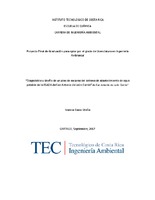Diagnóstico y diseño de un plan de mejoras del sistema de abastecimiento de agua potable de la ASADA de San Antonio de León Cortés” de San Antonio de León Cortés
Resumen
In Costa Rica, part of the population is supplied by communal or rural aqueducts; however, many operate under vulnerable conditions. For this reason, this research was proposed in order to evaluate and design an improvement plan for each of the ASADA aqueduct components of San Antonio de León Cortés, for which an operational control was performed at 18 control points measuring pH, turbidity, temperature, free residual chlorine, conductivity and total coliforms, fecal coliforms and E. coli, microbiological monitoring was performed by the most probable number technique, with monitoring being determined that turbidity, temperature and conductivity did not deliver problems . In addition, the presence of fecal coliforms and E. coli were found; In the same way, the water was obtained from acid. On the other hand, the SERSA Methodology was carried out in the storage tanks and storage tanks, which determines the level of risk of each of these hydraulic components; a semi-structured questionnaire was also applied to 125 users to determine the population's perception of the issues associated with water supply. Also, through the chlorine demand curve, the optimal chlorine dose was determined for all the properties of the aqueduct. In addition, the supply and demand of the water resource was estimated to determine the water availability of the aqueduct, where it was determined that the supply of the product is 257048 m3 / year, where only 13% of the total produced by the population user of the aqueduct. Also, it was determined that during 2017-2042 no water shortage was evidenced according to the arithmetic, geometric and exponential model of population growth in this community.
Descripción
Proyecto de Graduación (Licenciatura en Ingeniería Ambiental) Instituto Tecnológico de Costa Rica, Escuela de Química, 2017.


